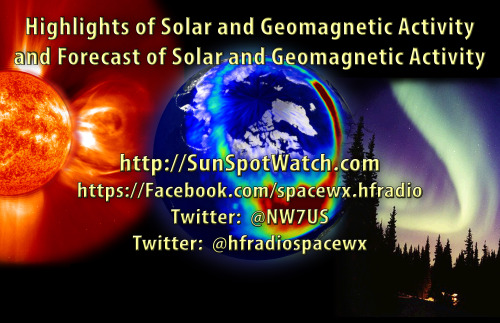The NW7US Beacon
RSS
Here is this week’s space weather and geophysical report, issued 2015 May 04 0612 UTC.
Highlights of Solar and Geomagnetic Activity 27 April - 03 May 2015
Solar activity was at very low to low levels during the period. Very low levels were observed on 27 April and on 02 May. Solar activity was in decline during the beginning of the period as Region 2331 (S10, L=021, class/area Dai/240 on 26 Apr) rotated around the SW limb on 29 April. Only isolated low level C-class flaring was observed for the majority of the period until new Region 2335 (S15, L=192, class/area Dai/220 on 02 May) rotated around the SE limb on 30 April. This region slowly developed in both area and magnetic class during its first few days on the visible disk and culminated in seven C-class flares; the largest of which was a C2 flare at 01/0257 UTC. Other activity of note included an 18 degree filament eruption, centered near S46E09, observed lifting off the visible disk between 02/1500-1830 UTC. Associated with this eruption was a partial-halo coronal mass ejection (CME) first observed in SOHO/LASCO C2 imagery at 02/2036 UTC with an approximate speed of 473 km/s. Although the majority of the ejecta appeared to be southward of the ecliptic plane, WSA/ENLIL modelling of the event showed a potential impact after midday on 06 May.
No proton events were observed at geosynchronous orbit.
The greater than 2 MeV electron flux at geosynchronous orbit was at normal to moderate levels. Moderate levels were observed on 27-29 April and again on 02-03 May.
Geomagnetic field activity was mostly quiet through late in the period. At approximately 30/0515 UTC, total field showed an increase from 6 nT to 11 nT with a weak increase in solar wind speed from approximately 280 km/s to 350 km/s. Further increases in speed to around 450 km/s occurred on 01 May as a weak, positive polarity coronal hole high speed stream (CH HSS) became geoeffective. CH HSS influence continued through the end of the period. The geomagnetic field responded with quiet to unsettled conditions on 02-03 May.
Forecast of Solar and Geomagnetic Activity 04 May - 30 May 2015
Solar activity is expected to be at very low to low levels with a chance for M-class (R1-R2, Minor-Moderate) flare activity from 04-21 May and again from 28-30 May with the return of old Regions 2322 (N11, L=116) and 2325 (N05, L=050).
No proton events are expected at geosynchronous orbit.
The greater than 2 MeV electron flux at geosynchronous orbit is expected to be at normal to moderate levels with high levels possible from 07-08, 13-21, and 29-30 May due to CH HSS activity.
Geomagnetic field activity is expected to be at quiet to unsettled levels from 05-07 May with active periods likely on 06-07 May due to a combination of CH HSS effects and the arrival of the 02 May CME by mid to late on 06 May. Unsettled to active conditions with likely minor storm periods (G1-Minor) are expected from 12-15 and 17-20 May due to a recurrent CH HSS. A weak CH HSS is expected to become geoeffective from 27-30 May causing quiet to unsettled conditions.
Don’t forget to visit our live space weather and radio propagation web site, at: http://SunSpotWatch.com/
Live Aurora mapping is at http://aurora.sunspotwatch.com/
If you are on Twitter, please follow these two users: + https://Twitter.com/NW7US + https://Twitter.com/hfradiospacewx
Get the space weather and radio propagation self-study course, today. Visit http://nw7us.us/swc for the latest sale and for more information!
Check out the stunning view of our Sun in action, as seen during the last five years with the Solar Dynamics Observatory (SDO): https://www.youtube.com/watch?v=zXN-MdoGM9g
We’re on Facebook: http://NW7US.us/swhfr

